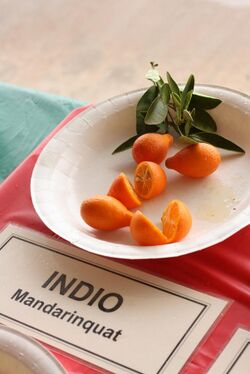Biology:Orangequat
| Nippon Orangequat | |
|---|---|
 | |
| Species | C. unshiu x C. japonica |
| Hybrid parentage | Citrus 'Satsuma' × Fortunella 'Meiwa' |
The Nippon orangequat is a cross between a Satsuma mandarin and a Meiwa kumquat (Fortunella crassifolia), hybridized by Dr. Eugene May of the USDA and introduced in 1932,[1] and is a member of the citrofortunella group. 'Nippon' is the only named cultivar.
Description
This is a small, round, orange fruit, which is larger than a kumquat. The fruit ranges from 2–4 cm (0.79–1.57 in) in circumference. Orangequats can be eaten whole, including rind, but they have a very bitter and sour taste and most contain seeds.[2][3] Orangequat trees are small to medium in size; the leaves are usually long and narrow and dark green in color.[4] The trunk and branches of the trees are slightly narrow, given the size of the trees. These trees can be seen with fruits on them through many of the colder months, since that is the season for orangequat growing. Orangequats have not been genetically altered to be resistant to citrus canker, a citrus disease that causes small round sores on the fruit and its tree. The orangequat also has not been bred to be seedless or sweet; it is very tart, and has a fair amount of rather large seeds inside.
Background
The Meiwa kumquat, a hybrid of a round and an oval kumquat, and the Satsuma mandarin are the two fruits that were used to parent the Nippon orangequat. Both of these fruits are able to withstand cooler climates, the meiwa being partially dormant in the winter months [5] and the satsuma maturing in October to December.[6] Since both of these citruses are able to grow in the colder season, the orangequat inherited that trait and is also grown and harvested in the colder seasons. Both of the parents of the orangequat are grown in many countries of the world, like China, Japan, South Africa, and the United States of America. In the United States, orangequats are mainly grown in the Southern states like Florida and Alabama; however, they are also grown in California and other Western states.
References
- ↑ "Swingle, Walter T. The Botany of Citrus and Its Wild Relatives". http://lib.ucr.edu/agnic/webber/Vol1/Chapter3.html#orangequats.
- ↑ "Citrus ID: Fact Sheet: Orangequat". http://idtools.org/id/citrus/citrusid/factsheet.php?name=Orangequat..
- ↑ "Powell, Arlie. Dr. Arlie Powell Orangequat". https://www.youtube.com/watch?v=dpvinNxnne8..
- ↑ Hodgson, Robert Willard. "Horticultural Varieties of Citrus". in Reuther, Walter. The Citrus Industry. 1. Kumquat Hybrids. http://websites.lib.ucr.edu/agnic/webber/Vol1/Chapter4.html#kumquats.
- ↑ "Swingle Meiwa". http://www.citrusvariety.ucr.edu/citrus/meiwa.html.
- ↑ "The Satsuma Mandarin". http://edis.ifas.ufl.edu/ch116.

